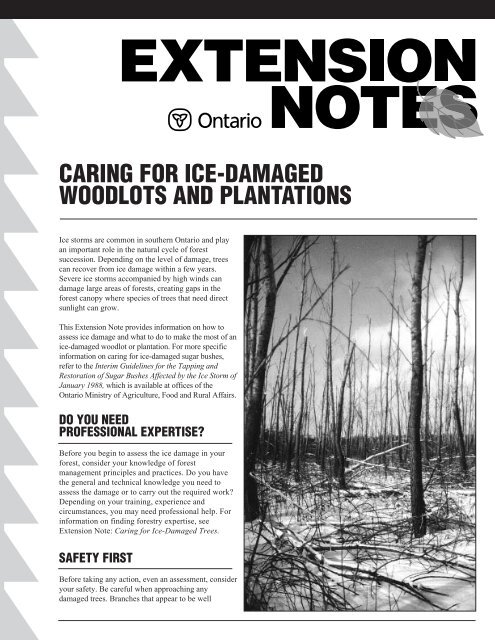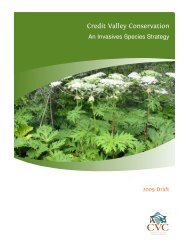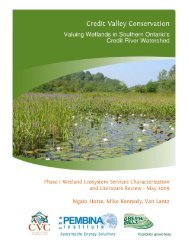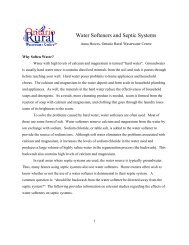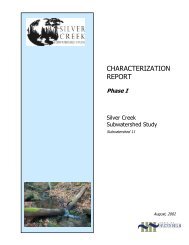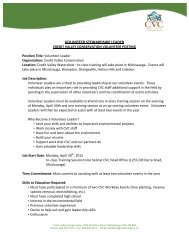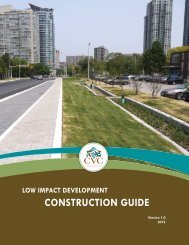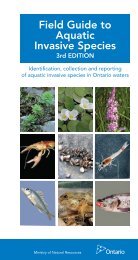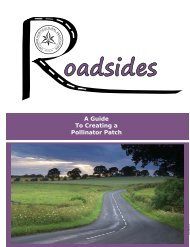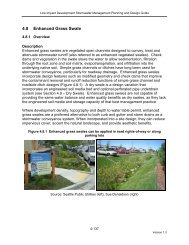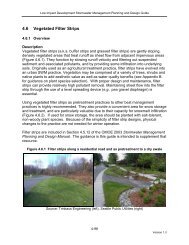caring for ice-damaged woodlots and plantations - LandOwner ...
caring for ice-damaged woodlots and plantations - LandOwner ...
caring for ice-damaged woodlots and plantations - LandOwner ...
You also want an ePaper? Increase the reach of your titles
YUMPU automatically turns print PDFs into web optimized ePapers that Google loves.
CARING FOR ICE-DAMAGEDWOODLOTS AND PLANTATIONSIce storms are common in southern Ontario <strong>and</strong> playan important role in the natural cycle of <strong>for</strong>estsuccession. Depending on the level of damage, treescan recover from <strong>ice</strong> damage within a few years.Severe <strong>ice</strong> storms accompanied by high winds c<strong>and</strong>amage large areas of <strong>for</strong>ests, creating gaps in the<strong>for</strong>est canopy where species of trees that need directsunlight can grow.This Extension Note provides in<strong>for</strong>mation on how toassess <strong>ice</strong> damage <strong>and</strong> what to do to make the most of an<strong>ice</strong>-<strong>damaged</strong> woodlot or plantation. For more specificin<strong>for</strong>mation on <strong>caring</strong> <strong>for</strong> <strong>ice</strong>-<strong>damaged</strong> sugar bushes,refer to the Interim Guidelines <strong>for</strong> the Tapping <strong>and</strong>Restoration of Sugar Bushes Affected by the Ice Storm ofJanuary 1988, which is available at off<strong>ice</strong>s of theOntario Ministry of Agriculture, Food <strong>and</strong> Rural Affairs.DO YOU NEEDPROFESSIONAL EXPERTISE?Be<strong>for</strong>e you begin to assess the <strong>ice</strong> damage in your<strong>for</strong>est, consider your knowledge of <strong>for</strong>estmanagement principles <strong>and</strong> pract<strong>ice</strong>s. Do you havethe general <strong>and</strong> technical knowledge you need toassess the damage or to carry out the required work?Depending on your training, experience <strong>and</strong>circumstances, you may need professional help. Forin<strong>for</strong>mation on finding <strong>for</strong>estry expertise, seeExtension Note: Caring <strong>for</strong> Ice-Damaged Trees.SAFETY FIRSTBe<strong>for</strong>e taking any action, even an assessment, consideryour safety. Be careful when approaching any<strong>damaged</strong> trees. Branches that appear to be well
wedged in the crown of a tree can fall without warning at anytime <strong>and</strong> cause severe injuries. Wear a hard hat at all times.Don’t go near any trees that are close to power lines. When itcomes time to care <strong>for</strong> your trees, don’t cut any largebranches or prune unless you have been trained to do so. Inrecognition of the dangers of these activities, anyone whooperates a chain saw <strong>for</strong> commercial purposes in Ontariomust be trained <strong>and</strong> certified.CONSIDER YOUR GOALSWhether or not you have a management plan <strong>for</strong> your woodlotor plantation, it’s important to consider your long-term goalsbe<strong>for</strong>e you begin your assessment. For example, if you wantto provide habitat <strong>for</strong> wildlife or places <strong>for</strong> recreation, youmay only want to clear access points <strong>and</strong> walking trails —even in severely <strong>damaged</strong> st<strong>and</strong>s. But if you’re managing ast<strong>and</strong> <strong>for</strong> timber products, you may want to harvest trees overthe next few years be<strong>for</strong>e they lose their commercial value.You may also want to prune <strong>and</strong> take other steps to avoidfuture losses. The options available to you will depend on thesite conditions, age of trees, species of trees <strong>and</strong> the extent of<strong>ice</strong> damage in your <strong>for</strong>est. Combined, these <strong>and</strong> otherconsiderations will determine whether your long-term goalsneed to be modified, whether investment in work on yourproperty will generate financial returns <strong>and</strong>, ultimately, whatyour plan of action should be to meet your goals.ASSESS THE DAMAGEIn most cases, it’s wise to wait one growing season be<strong>for</strong>e assessingyour <strong>for</strong>est. Waiting this length of time will enable you to see thefull effect of the storm without incurring any long-term financiallosses. Red pine <strong>plantations</strong> are an exception, however. Assess them<strong>and</strong> take any required action as soon as possible.1. DEFINE STANDSDetermine what kind of st<strong>and</strong>s you have. Look <strong>for</strong> areaswith different kinds of species or ages of trees. You mayfind that you have some of the following kinds of st<strong>and</strong>s.Follow these steps to assess the damage in each st<strong>and</strong> onyour property.
CARING FOR ICE-DAMAGEDWOODLOTS &PLANTATIONSDEFINE YOUR STANDLook at your st<strong>and</strong>, what are the majority of the trees, hardwoods or conifers?HardwoodMost trees are hardwoodsConiferMost trees are conifersImmature — most trees are less than 10 cm dbhMature — most trees are greater than 10 cm dbhYoung — most trees are less than 3 m tallMaturing — most trees are less than 15 cm dbhMature — most trees are greater than 15 cm dbh2. GATHER TOOLSYou’ll need the following:• flagging tape or tree-marking paint• clipboard• pencil• calipers or a yardstick <strong>and</strong> a string• one tally sheet <strong>for</strong> every st<strong>and</strong>3. SELECT SAMPLE PLOTSChoose three sample “plots” or spots to assess in each st<strong>and</strong>.The damage in the plots should be typical of the damage inthe st<strong>and</strong>.4. MARK SAMPLE TREESMark 10 trees in each sample plot with flagging tape or treemarkingpaint. Choose trees that are representative of all thedifferent species <strong>and</strong> sizes of trees in the woodlot. In <strong>plantations</strong>,choose five trees in two adjacent rows. Use the tally sheet(Table 1) to record the in<strong>for</strong>mation <strong>for</strong> each plot.5. RECORD SPECIESRecord the species name <strong>for</strong> sample trees.6. RECORD SIZEEstimate the diameter at approximately 1.3 metres above theground (dbh) of sample trees in hardwood st<strong>and</strong>s. Using thetable of “Hardwood Size Classification” on the tally sheet,determine a tree’s size class. Mark an “X” in the appropriatecolumn under “Size Classification.” In <strong>plantations</strong>, recordthe approximate age of the st<strong>and</strong> <strong>and</strong> tree height.7. ASSESS DAMAGE OF EACH TREE IN THE SAMPLE PLOTThe procedure <strong>for</strong> assessing damage varies according to themain kind of damage a st<strong>and</strong> has endured. Bending is themost common kind of damage in young hardwood st<strong>and</strong>s. Inthese st<strong>and</strong>s, assess the level of bending damage as shown inFigure 1. Broken branches <strong>and</strong> stems are the most commonkinds of damage in older st<strong>and</strong>s. This kind of damage iscalled “crown damage,” <strong>and</strong> it is assessed differently inhardwood <strong>and</strong> conifer st<strong>and</strong>s. Assess crown damage asshown in Figure 2 <strong>and</strong> 3. Record the appropriate damagecode <strong>for</strong> each tree on your tally sheet.8. SUMMARIZE RESULTSBending DamageFor st<strong>and</strong>s of bent saplings <strong>and</strong> trees tally the number oftrees in each “Bending Damage” category. Then calculatethe percentage of trees in each category. If more than75 per cent of the trees are in bending-category 1, considerthe damage to be minimal. If more than 50 per cent are incategory 3, consider the damage as severe. Consider allother conditions as moderate.Crown Damage in Hardwood St<strong>and</strong>sTotal the number of trees in each “Crown Damage”category. If more than 50 per cent of the trees are incategory 4, consider the damage to the st<strong>and</strong> to be severe.If more than 75 per cent of the trees are in category 1,consider the damage to be minimal. Consider all otherconditions to be moderate.For example, if you sampled three plots in a maturehardwood st<strong>and</strong> <strong>and</strong> 25 of the 30 trees sampled (75 per cent)were in damage class 1 (0 to 25 per cent crown damage),damage to this st<strong>and</strong> is minimal. If 10 of the 30 trees were incrown damage category 1 (no damage) <strong>and</strong> 15 were indamage class 2, damage in this st<strong>and</strong> is minimal as well.However, if 15 of the 30 trees sampled were in damagecategory 3, damage is moderate.Crown Damage in Conifer PlantationsTotal the number of trees in each “Crown Damage”category. If more than 50 per cent of trees are incategory 4, consider the damage to be severe. If more than75 per cent of the trees are in categories 1 <strong>and</strong> 2, considerthe damage to be minimal. Consider all other conditionsas moderate.Assess General St<strong>and</strong> ConditionIn natural hardwood <strong>woodlots</strong>, record your observationsabout smaller trees on the tally sheet. What species arepresent? Are they bent or broken? Are there many smallertrees (a sign of successful natural regeneration)? Also look<strong>for</strong> signs of insects or diseases. In oak st<strong>and</strong>s, recordwhether there are large numbers of gypsy moth eggmasses. Gypsy moth feeding can damage foliage, possiblykilling trees that are already under stress. To learn how toidentify gypsy moth egg masses, see Agriculture <strong>and</strong> AgrifoodCanada’s publication No Gypsy Moth Riders.In <strong>plantations</strong>, record observations about any other treesthat are growing around the planted trees. What species arepresent? Are they bent or broken? Are there many? Look<strong>for</strong> signs of insects or diseases. Pay attention to whitepines, which are susceptible to white pine blister rust.
CARING FOR ICE-DAMAGEDWOODLOTS &PLANTATIONSFIGURE 1:BENDINGDAMAGEWhen bending is the mostsignificant kind of damage in ast<strong>and</strong>, estimate the degree ofbending in each sample treeaccording to the following categories<strong>and</strong> mark an “X” in the “BendingDamage” column on the tally sheet.CategoryDegree ofBending1 less than 20 %2 between 20 <strong>and</strong> 60%3 over 60 degrees%FIGURE 2:CROWN DAMAGE INHARDWOOD STANDSEstimate the degree of damage to eachsample tree’s crown. Look at the placeswhere branches have broken <strong>and</strong> try toestimate how big these branches were be<strong>for</strong>ethe storm <strong>and</strong> how big the entire crown was.Then estimate the percentage of the crownthat remains <strong>and</strong> subtract that number from100 to get the percentage of the tree’s crownthat was lost. Don’t worry about beingprecise. Instead, place the tree in one of thefollowing categories <strong>and</strong> mark an “X” in the“Crown Damage” column on the tally sheet.1. 0–25% crown loss — 2.little effect26–50% crown loss —will surviveCategoryPercentage CrownLost1 0 to 25%2 26 to 50%3 51 to 75%4 greater than 75%51%–75% crown loss —3. fair chance of survival 4.>75% crown loss — maysurvive depending on species
FIGURE 3:CROWN DAMAGEIN CONIFERPLANTATIONSThe procedure <strong>for</strong> assessingdamage in <strong>plantations</strong> is the same<strong>for</strong> st<strong>and</strong>s of all ages <strong>and</strong> species(conifer <strong>and</strong> hardwood). Look <strong>for</strong>damage to a tree’s crown <strong>and</strong>determine which of the followingcategories best describes a sampletree’s condition. Then mark an “X”in the “Crown Damage” column onthe tally sheet.CategoryCrown Condition1 no damage2 leader <strong>and</strong> up to 2years growth broken3 broken in the middleof the crown4 less than 3 livebranches remaining2. 3. 4.Broken leader — will recover broken mid-crown —good chance of recovery>75% broken below crown —low chance of recovery
CARING FOR ICE-DAMAGEDWOODLOTS &PLANTATIONSDETERMINE WHAT TO DOAfter you have assessed the damage, consider the generalrecommendations below <strong>and</strong> the specific instructions inTable 2 to determine how to care <strong>for</strong> each st<strong>and</strong>.STRAIGHTENING BENT TREESDon’t pull trees to an upright position when they are stillfrozen. If you do, you could harm the tree. Gentlestraightening or pulling in the spring when the trees are moreflexible can be successful with smaller trees. Staking a tree tostraighten it is not economically viable in most cases.Scattered bent trees in mature <strong>for</strong>ests are not a major concern.Almost all trees that are bent less than 20 degrees willstraighten on their own. Most trees that are bent between20 <strong>and</strong> 60 degrees will likely straighten. Few trees bent morethan 60 degrees will straighten. If a tree has not straightenedon its own by June, it most likely will not do so.CONSIDER THE VALUE OF CONIFERS TO WILDLIFELiving conifers, no matter how severely <strong>damaged</strong>, providehabitat <strong>for</strong> wildlife. If <strong>damaged</strong> conifers are not safety hazards,you may want to leave them alone. You can also leave someconifers st<strong>and</strong>ing <strong>for</strong> wildlife habitat <strong>and</strong> cut others to theground to encourage faster decomposition. To prevent fires,remove large piles of broken trees <strong>and</strong> branches that are within150 metres of buildings <strong>and</strong> 30 metres of public roads.ENCOURAGE SPROUTINGMany <strong>damaged</strong> trees will produce ground-level sprouts thatcan regenerate the <strong>for</strong>est. Species that sprout readily are redmaple, silver maple, cherry, basswood, willow, oaks <strong>and</strong>poplars. To encourage sprouting, cut the tree down close tothe ground be<strong>for</strong>e the leaves come out in the spring.Bent trees that have straightened may have internal damagethat can affect their future commercial value.HARVESTING TREESWhen damage to a st<strong>and</strong> is minimal, little action is required.In moderate to severely <strong>damaged</strong> st<strong>and</strong>s, consider harvestingindividual trees or groups of trees that have category 4 crowndamage. This level of damage can eliminate species or agegroups from the st<strong>and</strong>. You may need expert adv<strong>ice</strong> to helpyou assess the implications of severe damage <strong>for</strong> the longtermhealth <strong>and</strong> value of your st<strong>and</strong>. An expert can also helpyou determine if there are markets <strong>for</strong> the kinds of woodproducts you have. For more in<strong>for</strong>mation on marketing woodproducts, consult the L<strong>and</strong>owner Timber Marketing Package,which is available through the L<strong>and</strong>Owner Resource Centre.
KEEP AN EYE ON THE FOREST — MONITORIt will take a few years be<strong>for</strong>e you will be able to determine theextent of the damage caused by a major <strong>ice</strong> storm. During thistime, keep a close eye on the <strong>for</strong>est. Many different stresses cancombine to cause serious damage. Check to see whether thereare insect infestations or diseases. Look at leaf size, shape <strong>and</strong>color. Watch <strong>for</strong> resin or gum on the bark <strong>and</strong> signs of insectfeeding, egg masses, conks <strong>and</strong> other fruiting bodies.Look at the trees you marked during the assessment <strong>for</strong> signsof change. This is best done in mid- to late summer be<strong>for</strong>e theleaves change color.If you don’t already have one, consider developing amanagement plan. Forests are complex ecosystems thatcontain many interdependent <strong>for</strong>ms of life. If you want to takewood from the <strong>for</strong>est over the long term or to develop a haven<strong>for</strong> wildlife <strong>and</strong> recreation, a management plan will help youachieve your goals <strong>and</strong> revitalize your woodlot. To find outmore about developing a plan, see the following publications:• A Woodlot Management Plan• Making Your Woodl<strong>and</strong> Pay• Extension Note: A Business Approach to OwningRural PropertyTABLE 2 — EXPECTATIONS AND RECOMMENDED ACTIONSMATURE HARDWOOD STANDSMinimal Damage• most trees will survive <strong>and</strong> grow a new crown within 10 years• harvest only those trees that have severely <strong>damaged</strong> stems or, ifeconomic value is important, <strong>damaged</strong> or deteriorating trees that couldlose their future potential <strong>for</strong> wood products• leave some <strong>damaged</strong> or deteriorating trees to provide snags <strong>and</strong> cavitytrees <strong>for</strong> wildlife• monitor st<strong>and</strong>’s health over several yearsIMMATURE HARDWOOD STANDSMinimal Damage• most trees will recover• trees bent less than 20 degrees will straighten• most trees bent 20 to 60 degrees will likely straighten• trees bent more than 60 degrees are not likely to straighten• allow bent trees until mid-summer to recover be<strong>for</strong>e taking action• cut broken trees to the ground be<strong>for</strong>e they get their leaves in the springto encourage sprouting from the stumpsMATURE HARDWOOD STANDSModerate Damage• most trees with 26% to 75% crown damage will survive but their growthrate may be reduced• most trees with more than 75% crown damage will not survive, except<strong>for</strong> basswood, beech, ash, poplar <strong>and</strong> willow• wait until the end of the first growing season to decide which trees to harvest• consider getting expert adv<strong>ice</strong> to determine which trees should beharvested to improve the long-term health of the <strong>for</strong>est• retain uncommon species, even if severely <strong>damaged</strong>, to maintain thediversity of species in the st<strong>and</strong>MATURE HARDWOOD STANDSSevere Damage• up to one quarter of the trees with more than 75% crown loss will survive• it may take several years <strong>for</strong> severely <strong>damaged</strong> trees to decline <strong>and</strong> die• extensive crown damage could open up the <strong>for</strong>est canopy allowing moresunlight to reach the <strong>for</strong>est floor, which will encourage the growth ofspecies that need sunlight to become established <strong>and</strong> change thespecies composition of the future <strong>for</strong>est• wait until the end of the first growing season to decide which trees to harvest• harvest trees in damage category 4• leave some severely <strong>damaged</strong> trees to provide snags <strong>and</strong> cavity trees<strong>for</strong> wildlife• retain uncommon species, even if severely <strong>damaged</strong>, to maintain thediversity of species in the st<strong>and</strong>• consider getting expert adv<strong>ice</strong> on the potential <strong>and</strong> necessity of acommercial harvest, the implications of future changes in speciescomposition <strong>and</strong> the best courses of actionIMMATURE HARDWOOD STANDSModerate Damage• cut broken trees to the ground be<strong>for</strong>e they get their leaves in the springto encourage sprouting from the stumps• allow bent trees until mid-summer to recover be<strong>for</strong>e taking action• consider regenerating areas of the st<strong>and</strong> that do not recover by midsummerby cutting all trees to the ground be<strong>for</strong>e the leaves come out thefollowing springIMMATURE HARDWOOD STANDSSevere Damage• bent trees are likely to survive but will remain bent• cut broken trees <strong>and</strong> trees that are bending more than 60 degrees to theground be<strong>for</strong>e they get their leaves in the spring to encourage sproutingfrom the stumps• consider regenerating areas of the st<strong>and</strong> that do not recover by midsummerby cutting all trees to the ground be<strong>for</strong>e the leaves come out thefollowing springYOUNG HARDWOOD PLANTATIONMinimal Damage• trees will survive <strong>and</strong> crowns are likely to recover• allow bent trees until mid-summer to recover be<strong>for</strong>e taking action• if future timber value is important, apply corrective pruning to trees indamage categories 1 <strong>and</strong> 2
CARING FOR ICE-DAMAGEDWOODLOTS &PLANTATIONSTABLE 2 — EXPECTATIONS AND RECOMMENDED ACTIONS CONTINUEDYOUNG HARDWOOD PLANTATIONModerate Damage• broken trees will probably produce sprouts• allow bent trees until mid-summer to recover be<strong>for</strong>e taking action• if future timber value is important, apply corrective pruning to trees indamage categories 1 <strong>and</strong> 2• if the planted species sprouts easily, consider cutting stems in damagecategory 3 to the ground to encourage new growth from the stumpsYOUNG HARDWOOD PLANTATIONSevere Damage• trees broken mid-stem may sprout• if the species sprouts easily, cut all stems to the ground to regeneratethe st<strong>and</strong>HYBRID POPLAR PLANTATIONSMinimal Damage• allow bent trees until mid-summer to recover be<strong>for</strong>e taking action• consider cutting to the ground trees that do not recover by mid-summerto encourage regeneration through sprouting• leave some trees as potential cavity trees <strong>for</strong> wildlifeHYBRID POPLAR PLANTATIONSModerate Damage• allow bent trees until mid-summer to recover be<strong>for</strong>e taking action• cut to the ground trees that have broken stems <strong>and</strong> no living crown toencourage regeneration through sprouting• consider planting coniferous species under trees in heavily <strong>damaged</strong> areas• trees with broken branches but intact stem may regrow a crown• monitor trees over the growing seasonHYBRID POPLAR PLANTATIONSSevere Damage• allow bent trees until mid-summer to recover be<strong>for</strong>e taking action• if trees are more than 15 centimetres dbh, get expert adv<strong>ice</strong> about thepotential of a commercial harvest• leave <strong>damaged</strong> trees alone if they have conifers growing under them• monitor to see if trees are sprouting from the stems <strong>and</strong> remaining branches• assess the st<strong>and</strong> frequently in coming yearsMATURE AND MATURING CONIFER PLANTATIONSMinimal Damage• there is little that can be done to protect the commercial value of treesthat are <strong>damaged</strong> above the height of 5 metres• consider harvesting dead trees to decrease risk of insect infestationFIGURE 4: CORRECTIVE PRUNING IN HARDWOODSDAMAGE TO LARGE BRANCHESCut AMake your first cut two feet from the trunk.Cut half way through the branch, movingfrom the bottom up.Cut BThe second cut is one-third to half thediameter of the limb away from the first cut.Cut half way through the branch. At this point,the limb should fall from its own weight.Cut CThe final cut is next to the trunk. Cutoutside the branch collar with the loweredge being further away from the trunk ofthe tree.Bark RidgeCut CCut BCut ABranch CollarDAMAGE AT THE TOP OF THE TREEA clean, 45 degreecut at the top of thetree will preventwater from pooling<strong>and</strong> rotting thetrunk. Make the cutbelow the break <strong>and</strong>above the next livebranch that is atleast one-third thesize of the stem.
FIGURE 5: CORRECTIVE PRUNING IN CONIFERSChoose the strongest branch in the highest whorl as afuture leader. Prune back the broken leader until it’s about10 centimetres long. Use tape or other biodegradablematerial to tie the new leader into position. With larger treeswhere it is not possible to tie up a branch, choose a newleader <strong>and</strong> prune back the remaining branches to one-thirdthe length of the chosen leader.For larger treesbroken leadernew leaderremainingbranchespruned backFor smaller treesbroken leaderbrokenleaderremovednew leadertied intopositionTABLE 2 — EXPECTATIONS AND RECOMMENDED ACTIONS CONTINUEDMATURE AND MATURING CONIFER PLANTATIONSModerate Damage• there is little that can be done to protect the commercial value of treesthat are <strong>damaged</strong> above the height of 5 metres• harvest as few trees as possible to retain the density of trees in the st<strong>and</strong><strong>and</strong> to encourage <strong>damaged</strong> trees to grow new leaders• harvest red pine <strong>and</strong> white pine trees with commercial value (generallylarger than 15 centimetres dbh) that are in damage categories 3 <strong>and</strong> 4be<strong>for</strong>e June to reduce risk of blue stain fungus• cut to the ground the remaining trees that are in damage category 4, aswell as severely bent trees, to encourage decomposition• leave a few <strong>damaged</strong> trees as potential cavity trees <strong>for</strong> wildlifeMATURE AND MATURING CONIFER PLANTATIONSSevere Damage• trees in damage category 4 are likely to die• harvest red pine <strong>and</strong> white pine with commercial value (generally largerthan 15 centimetres dbh) that are in damage categories 3 <strong>and</strong> 4 be<strong>for</strong>eJune to reduce risk of blue stain fungus• cut to the ground the remaining trees that are in damage category 4, aswell as severely bent trees, to encourage decomposition• leave a few <strong>damaged</strong> trees as potential cavity trees <strong>for</strong> wildlife• consider restoring the site to a hardwood <strong>for</strong>est if hardwood regeneration ispresent (see Extension Note: Managing Regeneration in Conifer Plantationsto Restore a Mixed Hardwood ForestYOUNG WHITE PINE AND RED PINE PLANTATIONSMinimal Damage• trees with broken tops will survive <strong>and</strong> a new leader will take over• allow bent trees until mid-summer to recover be<strong>for</strong>e taking action• consider applying corrective pruning to trees with <strong>damaged</strong> leadersYOUNG WHITE PINE AND RED PINE PLANTATIONSModerate Damage• consider corrective pruning of crop trees to maintain theircommercial value• if you have not chosen crop trees, select up to 500 evenly spaced treesper hectare (200/acre) as crop trees, including as many un<strong>damaged</strong> treesas possible
CARING FOR ICE-DAMAGEDWOODLOTS &PLANTATIONSTABLE 2 — EXPECTATIONS AND RECOMMENDED ACTIONS CONTINUED• do not choose as crop trees those in damage class 3 or those that areinfected with white pine blister rust• harvest as few trees as possible to retain the density of trees in the st<strong>and</strong><strong>and</strong> to encourage <strong>damaged</strong> trees to grow new leadersYOUNG WHITE PINE AND RED PINE PLANTATIONSSevere Damage• trees in category 3 <strong>and</strong> 4 are likely to respond to corrective pruning• cut dead trees to the ground to encourage decomposition• harvest as few trees as possible to retain the density of trees in the st<strong>and</strong><strong>and</strong> to encourage <strong>damaged</strong> trees to grow new leaders• consider harvesting <strong>and</strong> replanting heavily <strong>damaged</strong> areas (seeExtension Note: Planning <strong>for</strong> Tree Planting)YOUNG WHITE SPRUCE, NORWAY SPRUCEAND TAMARACK PLANTATIONSMinimal Damage• trees that have lost their leaders will likely recover because these specieshave many lateral buds that can <strong>for</strong>m new leadersYOUNG WHITE SPRUCE, NORWAY SPRUCEAND TAMARACK PLANTATIONSModerate Damage• trees that have lost their leaders will likely recover because these specieshave many lateral buds that can <strong>for</strong>m new leaders• harvest as few trees as possible to retain the density of trees in the st<strong>and</strong><strong>and</strong> to encourage <strong>damaged</strong> trees to grow new leaders• cut dead trees to the ground to encourage decompositionYOUNG JACK PINE STANDSSevere Damage• cut trees in damage category 4 <strong>and</strong> severely bent trees to the ground toreduce the risk of <strong>for</strong>est fires• consider restoring the site to a hardwood <strong>for</strong>est if hardwood regenerationis present (see Extension Note: Managing Regeneration in ConiferPlantations to Restore a Mixed, Hardwood Forest)• consider harvesting <strong>and</strong> replanting heavily <strong>damaged</strong> areas (seeExtension Note: Planning <strong>for</strong> Tree Planting)CEDAR STANDSMinimal Damage• most cedars will grow new crowns• consider harvesting severely <strong>damaged</strong> treesCEDAR STANDSModerate Damage• some cedars will grow new crowns• consider harvesting patches of severely <strong>damaged</strong> trees• cut dead trees to the ground to encourage decompositionCEDAR STANDSSevere Damage• consider harvesting patches of severely <strong>damaged</strong> trees• cut dead trees to the ground to encourage decomposition• if the cedar st<strong>and</strong> is part of a deer yarding area remove fallen branches<strong>and</strong> debris from deer trailsYOUNG WHITE SPRUCE, NORWAY SPRUCEAND TAMARACK PLANTATIONSSevere Damage• harvest as few trees as possible to protect the plantation’s density <strong>and</strong>encourage trees to grow new leaders• cut dead trees to the ground to encourage decomposition• consider harvesting <strong>and</strong> replanting heavily <strong>damaged</strong> areas (seeExtension Note: Planning <strong>for</strong> Tree Planting)YOUNG JACK PINE STANDSMinimal Damage• <strong>damaged</strong> trees will enrich the soil, protect soil from erosion <strong>and</strong> providehabitat <strong>for</strong> wildlife <strong>and</strong> a cover crop <strong>for</strong> hardwood regeneration• no action requiredYOUNG JACK PINE STANDSModerate Damage• consider corrective pruning of <strong>damaged</strong> trees if timber value is important• cut trees in damage category 4 <strong>and</strong> severely bent trees to the ground toreduce the risk of <strong>for</strong>est fires• retain some <strong>damaged</strong> trees as potential cavity trees <strong>for</strong> wildlife
CARING FOR ICE-DAMAGEDWOODLOTS &PLANTATIONSFOR MORE INFORMATIONFor more in<strong>for</strong>mation on <strong>caring</strong> <strong>for</strong> <strong>ice</strong>-<strong>damaged</strong> trees, contactyour nearest off<strong>ice</strong> of the Ministry of Natural Resources. Forspecific in<strong>for</strong>mation on sugar bushes or nut trees, contact theMinistry of Agriculture, Food <strong>and</strong> Rural Affairs.The following Extension Notes will help you care <strong>for</strong> yourwoodlot or plantation:• Cavity Trees are Refuges <strong>for</strong> Wildlife• Managing Regeneration in Conifer Plantations to Restorea Mixed, Hardwood Forest• Managing Young Hardwood St<strong>and</strong>s <strong>for</strong> Sawlog Production• Planning <strong>for</strong> Tree Planting• Selling St<strong>and</strong>ing TimberFurther reading:• A True Picture Taking Inventory of Your Woodlot, EasternOntario Model Forest, 1997• Diagnosing Injury to Eastern Forest Trees: A Manual <strong>for</strong>Identifying Damage Caused by Air Pollution, Pathogens,Insects, <strong>and</strong> Abiotic stresses. Penn State College ofAgriculture, Penn State University, 1987• Field Guide to Tree Diseases of Ontario, C. Davis <strong>and</strong> T.Meyers, NODA/NFP Tech Report TR-46, 1997• Interim Guidelines <strong>for</strong> the Tapping <strong>and</strong> Restoration ofSugar Bushes Affected by the Ice Storm of January 1998.MNR <strong>and</strong> OMAFRA, 1998• L<strong>and</strong>owners Timber Marketing Package, ResourceStewardship of S.D. & G, 1997• Making Cents out of Forest Inventories: A Guide <strong>for</strong> SmallWoodlot Owners, 1998• No Gypsy Moth Riders, Agriculture <strong>and</strong> Agri-Food Canadapamphlet, publication number 1516BDEFINITIONSDBH (diameter at breast height)Diameter of a tree trunk measured 1.3 metres above the ground.LeaderShoot growing at the top of a tree’s stem or principal branch.RegenerationYoung trees <strong>and</strong> the process of establishing young trees.SuccessionSuccession is the natural process of change that occurs in a <strong>for</strong>estover time as one community of living organisms replaces another. Insouthern Ontario, the cycle of succession usually begins when an<strong>ice</strong> storm, high wind or fire creates gaps in the <strong>for</strong>est cover. Thisevent launches a cycle of succession which may include severaldifferent kinds of ecosystems. The cycle can take hundreds orthous<strong>and</strong>s of years.WhorlRing of branches around the stem of a plant.For more in<strong>for</strong>mation contact:L<strong>and</strong>Owner Resource CentreP.O. Box 599, 5524 Dickinson StreetManotick, Ontario K4M 1A5Tel 613 692 2390 or 1 800 387 5304Fax 613 692 2806Product Ordering: 1-888-571-INFO (4636)E-mail: info@lrconline.comInternet: http://www.lrconline.comProduced by:• L<strong>and</strong>Owner Resource CentreWith support from:• Ontario Ministry of Natural ResourcesHuman ResourcesDevelopment CanadaDéveloppement desressources humaines CanadaISSN 1198-3744R.P. (5k P.R., 99 05 03)©1999, Queen’s Printer <strong>for</strong> OntarioPrinted in Ontario, CanadaCette publication est égalementdisponible en français.® printed on recycled paper


